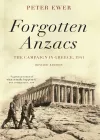Forgotten ANZACS: The Campaign in Greece, 1941
Written by: Peter Ewer,
Scribe Publications, Carlton North, 2008,
ISBN: 9781925321296, 419pp.
Reviewed by: Glyn Harper
This book deals with the dispatch of W Force to Greece in the early months of 1941 and its ultimate fate. Consisting primarily of the Australian 6th Division fresh from its triumphs in North Africa and the 2nd New Zealand Division, W Force was a token military commitment made by the British Government even though they knew it had little chance of success. However, the British Government had issued a guarantee to protect Greek sovereignty in 1940 and such a commitment, even one as small as W Force, could produce considerable benefits, or so the British Government thought. First, it was intended to show British resolve in a moral cause of protecting small, vulnerable nations. Such resolve would impress the United States and could lead to the forming of a Balkan front against the Germans and could even lead to Turkey entering the war. Such forlorn hopes soon evaporated before the might of a German war machine which committed some 27 Divisions and over 1000 Axis aircraft to its invasion of Greece. The Greek campaign became one long, hazardous withdrawal for W Force. Eventually two Gallipoli style evacuations from the mainland of Greece and from the island of Crete would become necessary. Unfortunately though, not all the ANZAC soldiers who took part could be rescued and thousands had to be left behind, with most left facing long years of captivity ahead of them.
Peter Ewer is a senior official in the Victorian Department of Justice and holds a doctorate in technology and culture from RMIT. This is his first book. In Forgotten ANZACS Ewer seeks to tell the full story of the campaigns in Greece and Crete in 1941 but primarily from an ANZAC perspective. And while there is much to like about this account of the Greek campaign, Ewer is only partially successful in achieving his aim.
It is thoroughly laudable that Ewer recognises that there were two nations involved in this ANZAC debacle but the treatment of the New Zealand involvement in this campaign is relatively superficial. Ewer has only looked at three files on the Greek campaign in the New Zealand National Archives, something it would take a researcher armed with a digital camera less than an hour to do. None of the New Zealand unit and formation war diaries have been used, nor has the voluminous correspondence of the official historian of the campaign been consulted either. Ewer’s secondary sources were primarily the two New Zealand official histories as well as the various unit histories. Recent biographies of the two key New Zealand commanders Freyberg and Kippenberger have been ignored, as have the recent New Zealand publications on the campaign. Ian McGibbon’s scholarly overview of New Zealand at war published in 2005 has been ignored too.
This leads to some rather distorted and almost condescending views of the New Zealand performances in both Greece and Crete. Based on the evidence, as outlined in these recent publications, it is now generally accepted that the New Zealand 21 Battalion performed poorly at Pinios Gorge in Greece with its commander issuing his final order: ‘Head for the hills. It’s every man for himself.’ It is also generally accepted that Crete was lost to the allies primarily because of a sequence of serious New Zealand command failures at all levels of command. None of these failures are recorded in Forgotten ANZACS.
Ewer is on firmer ground in dealing with the Australian involvement and he is also comfortable criticising Generals Wilson and Blamey for their poor performances. Blamey’s early departure from the campaign and his insistence on taking his son with him was inexcusable. Ewer’s assessment that Blamey’s haste to comply with ‘the most incomprehensible order of the whole campaign’ was ‘unseemly’ is spot on. The attention Ewer gives to what was happening on ‘the other side of the hill’—that is, to German plans and how they unfolded, is also a welcome feature in Forgotten ANZACS. Another considerable strength of Ewer’s book is his use of oral sources. Ewer has interviewed thirty-three veterans of the campaign on both sides of the Tasman and these recollections have been skilfully woven into the narrative. They make the events of the campaign come alive.
This book is a valuable addition to the history of a campaign that is often overlooked on both sides of the Tasman. Anyone with an interest in what happened in Greece and Crete in 1941 or in what ANZAC combat veterans experienced in the early years of the Second World War should read it. It is a great pity, however, that Ewer’s cursory use of New Zealand sources prevents him from achieving the truly ANZAC perspective he was attempting to achieve.

